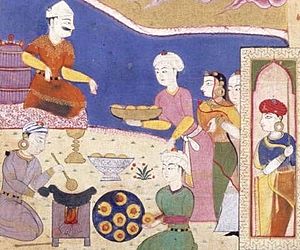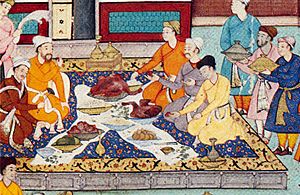Indian cookbooks facts for kids
Indian cookbooks are special books that tell us how to make delicious Indian food. Some of the very first cookbooks ever written came from India! Indian cooking is different in various parts of the country. It has changed a lot over hundreds of years because of many different influences. Eating mostly plant-based foods (vegetarianism) has had a big effect on Indian cooking. Spices are also super important in almost all Indian dishes.
Contents
Ancient Indian Cookbooks
Ayurvedic Samhitas (around 4th century BCE) are ancient health texts. They suggested that foods can help balance your mind. These texts also described how to cook different foods. They included recipes for rice, lentil dishes (like khichadi), and even minced meat dishes. They also talked about using meats, milk, vegetables, and fruits. These books listed spice mixes like "Trikatu" (pepper and ginger). They also mentioned turmeric, cumin, and coriander. A chapter in the Sushruta Samhita even taught about table manners and how to serve food!
Sangam literature (from 6th century BCE to 3rd century CE) gives us clues about food from that time. It describes big feasts at kings' palaces and simple meals in villages. It even tells us what travelers ate. Poets wrote about the food they enjoyed. For example, one poet described a summer lunch with "steamed rice, mashed eggplant, and tangy buttermilk." Another poet wrote about a royal lunch with "skewered goat meat, crispy fried vegetables, and over 16 kinds of dishes."
Lokopakara (1025 CE) was written by Chavundaraya. This cookbook is all about vegetarian recipes. It teaches how to cook rice, lentils, and many vegetables. It also explains how to use spices and make spice blends. The book talks about different cooking pots and how to use them. It even has tips for preserving food, like making pickles. You can also find ways to make butter, ghee, and flavored yogurts.
Manasollasa (1130 AD) is a famous text from the time of King Someshvara III. It has recipes for both vegetarian and non-vegetarian foods. It also includes dishes made from fermented grains. For meat dishes, it describes recipes using pork, deer, goat, and fish. This book might have one of the earliest mentions of "Idli," a popular South Indian dish.
Pakadarpana (1200 AD) is another recipe book about cooking art. It has 11 chapters. This book lists both vegetarian and non-vegetarian recipes. It gives details on how to cook rice, meats, and vegetables. It also explains how to prepare food for different seasons. For example, it describes many types of meat-and-rice dishes, like chicken rice. It also includes recipes for refreshing drinks made from mango and lemon.
Soopa Shastra (1508 A.D.) was written by Mangarasa III. He was a follower of Jainism, so this book is completely vegetarian. It gives very detailed instructions for ingredients and cooking methods. It even tells you what types of pots and ovens to use. The first chapter describes many breads, sweets, and snacks. Other chapters include recipes for drinks, different types of rice dishes, and vegetable dishes. It has recipes for eggplant, jackfruit, and raw bananas. Interestingly, it mentions onions, which strict Jains usually avoid.
Kshemakutuhala (1549 A.D) was written by Ksemasarma. This cookbook has both vegetarian and non-vegetarian recipes. For meat, it includes boar, lamb, goat, and different birds. It lists nine ways to cook meat. The book also explains how to cook rice, lentils, and use spice mixtures. It has a very long chapter about cooking many different vegetables, leaves, and roots. The last chapter is all about refreshing drinks.
Bhojana Kutuhala (1675 A.D) was written by Raghunatha. This book talks about many ingredients and dishes popular in the Maharashtra region. It brings together a lot of old knowledge about food and cooking from ancient times. It also discusses healthy eating and cooking methods.
Cookbooks from Sultanate and Mughal Times
During the time of the Turkic Sultanate and Mughal rulers, many new foods came to India. These included popular dishes like samosa, korma, kebab, and halva.
The Ni'matnama (around 1500) is a collection of recipes from the Malwa Sultanate. It has cooking recipes and even some remedies. It also talks about preparing betel leaves. This book includes unique pickles made from edible flowers. You can find recipes for minced meat, samosas, and sherbets (sweet drinks).
The Ain-i-Akbari (1590) was written during the time of the Mughal emperor Akbar. It has many recipes, mostly those enjoyed by the royal family. This book divides recipes into three groups: meat-free dishes, meat-and-rice dishes, and meats cooked with spices.
Alwan-e-Nemat (17th-century) has 101 recipes from Emperor Jahangir's kitchen. A chapter in this book also talks about dining etiquette. It describes how to set up a "Dastarkhan," which was a special dining spread. People would eat together from large shared plates, just like their ancestors in Central Asia.
Nuskha-e-Shahjahani contains recipes for different kinds of Pilaf (seasoned rice) from Emperor Shah Jahan's time.
British Period Cookbooks
During British rule, many cookbooks were published. Some were for British people living in India. Others were for local people, often in languages like Gujarati, Bengali, and Hindi. Some examples include:
- Pak-Shastra, 1878 (Gujarati)
- Culinary Jotting for Madras, 1891
- Mistanna Pak, 1904 (Bengali)
- Bengal Sweets, 1921
- Indian Cookery, 1930s, by Veeraswamy (who started a famous Indian restaurant in England).
- Vrahad Pak Vigyan, 1939 (Hindi)
During this time, Bengali sweets like the Rasgulla became popular. Also, "English Vegetables" like cabbage, cauliflower, and tomatoes became common in Indian cooking. The Vrahad Pak Vigyan even had a special section on "English" cooking. It included recipes for biscuits, breads, and dishes with tomatoes and mushrooms.
After Indian Independence

After India became independent, more cookbooks appeared:
- Dalda Cookbook, 1949 (a popular book published in English, Hindi, Tamil, and Bengali).
- Modern Cookery Vol I, 1946, by Thangam Philip.
- Indian Cooking, 1954, by Savitri Chawdhary (an Indian housewife who moved to England).
When many families moved from Punjab and Sindh, foods like Samosa, Nan, and Chhole became very popular. Also, as people from South India moved North, South Indian dishes became common there too.
Indian Cooking Goes Global
As many Indians moved to North America, and as international influences came to India, new cookbook authors became famous.
- An Invitation to Indian Cooking, 1973, by Madhur Jaffrey. She has written many popular cookbooks since then.
- Classic Indian Cooking, 1980, by Julie Sahni. She started an Indian Cooking School in New York City in 1973.
- Lord Krishna's Cuisine: The Art of Indian Vegetarian Cooking, 1987, by Yamuna Devi.
With TV and the internet, even more food authors have appeared in recent years. International travel has also made Indian cooking more famous around the world.
- The Pleasures of Vegetarian Cooking, 1974, by Tarla Dalal. She wrote over 170 cookbooks!







